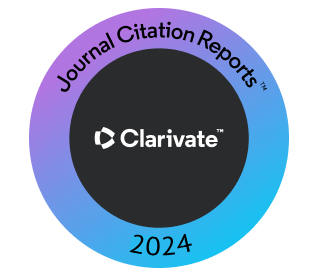Investigations of Flare Gas Emissions in Taq Taq Oil Field on the Surrounding Land
Abstract
Environmental pollution caused by oil takes many different forms; one of the most damaging sources is simply the combustion of oil products, such as a well flare burn-off. This paper presents the results of a survey of the agriculture lands around the Taq Taq Oil Production Company. The aim of the survey was to determine the potential contamination caused by the gas emissions from the well flares. Taq Taq field is located in the Kurdistan Region of Iraq, 60 km north of the giant Kirkuk oil field, 85 km south-east of Erbil and 120 km north-west of Suleimani. Samples of soil were collected from several locations around the site and analyzed to determine the content of Polycyclic Aromatic Hydrocarbons PAH present. A gas chromatography linked to a mass spectrometry (GCMS) machine was used for these measurements. The PAH contamination at each location of soil was determined and the 16-PAHs, as listed in the US Environmental Protection Agency (EPA) documentation were investigated. The average content of total PAH in all samples of the agricultural soil was 0.654 mg·kg-1 with the concentrations ranging from 0.310 to 0.869 mg·kg-1. It was found that the PAH concentrations decreased with increasing distance from the TTOPCO oil field, indicating that pollution was evident, the area close to the field being more affected by the gas pollution.Downloads
References
Bishnoi, N.R., Mehta, U., Sain, U. and Pandit, G., 2005. Quantification of polycyclic aromatic hydrocarbons in tea and coffee samples of Mumbai city using high performance liquid chromatography. Environ. Monit. Assess., 107(1-3), pp.399-406.
Berset, J.D., Ejem, M., Holzer, R. and Lischer, P., 1999. Comparison of different drying, extraction and detection techniques for the determination of priority polycyclic aromatic hydrocarbons in background contaminated soil samples. Anal. Chim. Acta, 383(3), pp.263-275.
Cousins, I.T., Beck, A.J. and Jones, K.C., 1999. A review of the process involved in the exchange of semi-volatile organic compounds (SVOC) across the air-soil interface. Science of the Total Environment, 228(1), pp.5- 24.
Ene, A., Bogdevich, O., Sion, A. and Spanos, T., 2012. Determination of polycyclic aromatic hydrocarbons by gas chromatography–mass spectrometry in soils from southeastern Romania. Microchem. J. 100(1), pp.36–41.
Hati, S.S., Dinar, G.A., Egwu, G.O. and Ogunbuaja, V.O., 2009. Polycyclic Aromatic Hydrocarbons (PAHs) contamination of synthetic industrial essentials utilized in the Northern Nigeria. African Journal of Pure and Applied Chemistry, 3(5), pp. 86 – 91.
Jones, K.C., Stratford, J.A., Waterhouse, K.S. and Vogt, N.B., 1989. Organic contaminants in Welsh soils: Polycyclic aromatic hydrocarbons. Environmental Science and Technology, 23, pp.540–550.
Jones, K.C., 1991. Contaminant trends in soils and crops. Environ. Pollut. 69(4), pp.311-325.
Kuosmanen, K., Hyötyläinen, T., Hartonen, K. and Riekkola, M.L., 2003. Analysis of polycyclic aromatic hydrocarbons in soil and sediment with on-line coupled pressurised hot water extraction, hollow fibre microporous membrane liquid– liquid extraction and gas chromatography. Analyst,128(5), pp.434–439.
Mackay, D., 2001. Multimedia Environmental Models: the Fugacity Approach, 2nd ed. Lewis/CRC, Boca Raton FL.
Prycek J., Ciganek, M. and Srinek, Z., 2007. Clean up of extracts for nitrated derivatives of polycyclic aromatic hydrocarbons analysis prior their gas chromatography determination. Journal of the Brazilian Chemical Society, 18(6), doi:10.1590/S0103-50532007000600004.
Sexton, K., Sahmas, J.J., MacDonald, T.J., Gowen, R.M.Z., Miller R.P., McCormick, J.B. and Fisher-Hosh, S.P., 2011. PAHs in Maternal Unbilical cord blood from pregnant Hispanic women living in Brownsville, Texas. International Journal Environmental Research and Public Health, 8(8), pp.3365 – 3379.
Sinopec – Addax Petroleum Foundation – Middle East, 2013. [Online] Available at https://www.addaxpetroleum.com/operations/middle-east. [Accessed 25 July 2013].
Yang, F., Long, Y.M., Shen, R., Chen, C.Y., Pan, D., Zhang, Q.L., Cai, Q.Y. and Yao, S.Z., 2011. Ultrasonication extraction coupled with magnetic solid-phase clean-up for the determination of polycyclic aromatic hydrocarbons in soils by high-performance liquid chromatography. J. Sep. Sci. 34(6), pp.716–723.
Zuazagoitia, D., Millán, E. and Garcia-Arrona, R., 2009. Comparison of two extraction methods for the determination of polycyclic aromatic hydrocarbons in surface soils using headspace SPME with GC–FID. J. Chromatogr. Sci., 47(2), pp.97–102.
Copyright (c) 2014 Loghman A. Khodakarami

This work is licensed under a Creative Commons Attribution-NonCommercial-ShareAlike 4.0 International License.
Authors who choose to publish their work with Aro agree to the following terms:
-
Authors retain the copyright to their work and grant the journal the right of first publication. The work is simultaneously licensed under a Creative Commons Attribution License [CC BY-NC-SA 4.0]. This license allows others to share the work with an acknowledgement of the work's authorship and initial publication in this journal.
-
Authors have the freedom to enter into separate agreements for the non-exclusive distribution of the journal's published version of the work. This includes options such as posting it to an institutional repository or publishing it in a book, as long as proper acknowledgement is given to its initial publication in this journal.
-
Authors are encouraged to share and post their work online, including in institutional repositories or on their personal websites, both prior to and during the submission process. This practice can lead to productive exchanges and increase the visibility and citation of the published work.
By agreeing to these terms, authors acknowledge the importance of open access and the benefits it brings to the scholarly community.















 ARO Journal is a scientific, peer-reviewed, periodical, and diamond OAJ that has no APC or ASC.
ARO Journal is a scientific, peer-reviewed, periodical, and diamond OAJ that has no APC or ASC.